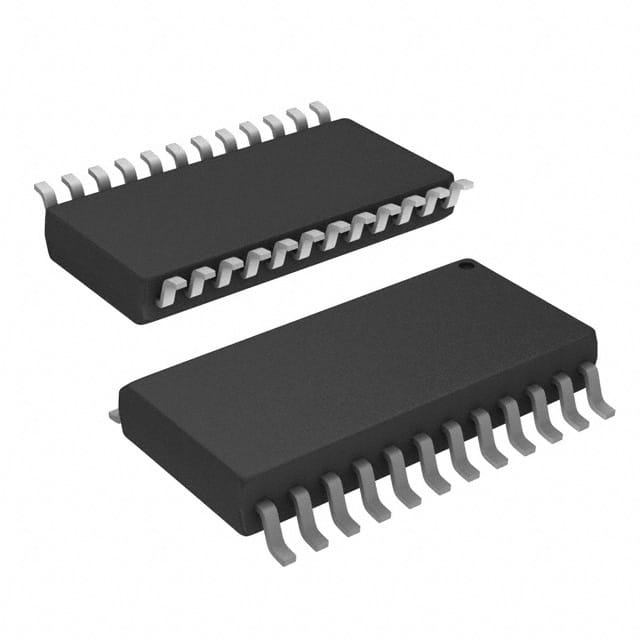Lihat spesifikasi untuk detail produk.

SN74ABT646DWR
Product Overview
- Category: Integrated Circuit (IC)
- Use: Bus Transceiver and Register
- Characteristics: High-speed, low-power, bidirectional transceiver with 3-state outputs
- Package: SOIC (Small Outline Integrated Circuit) package
- Essence: The SN74ABT646DWR is a versatile IC that allows bidirectional data transfer between two buses of different voltage levels. It can also be used as a register for storing data.
- Packaging/Quantity: Available in reels of 2500 pieces
Specifications
- Supply Voltage Range: 4.5V to 5.5V
- Input Voltage Range: 0V to VCC
- Output Voltage Range: 0V to VCC
- Operating Temperature Range: -40°C to +85°C
- Maximum Data Rate: 100MHz
Detailed Pin Configuration
The SN74ABT646DWR has a total of 24 pins. Here is the detailed pin configuration:
- OE (Output Enable) - Output enable control pin
- A1-A3 (Bus A Inputs) - Input pins for bus A
- B1-B3 (Bus B Inputs) - Input pins for bus B
- DIR (Direction Control) - Direction control pin
- GND (Ground) - Ground reference pin
- B4-B6 (Bus B Outputs) - Output pins for bus B
- B7-B9 (Bus B Inputs) - Input pins for bus B
- VCC (Supply Voltage) - Positive supply voltage pin
- A4-A6 (Bus A Outputs) - Output pins for bus A
- A7-A9 (Bus A Inputs) - Input pins for bus A
- NC (No Connection) - No connection pin
- B10-B12 (Bus B Outputs) - Output pins for bus B
- B13-B15 (Bus B Inputs) - Input pins for bus B
- GND (Ground) - Ground reference pin
- A10-A12 (Bus A Outputs) - Output pins for bus A
- A13-A15 (Bus A Inputs) - Input pins for bus A
- VCC (Supply Voltage) - Positive supply voltage pin
- DIR (Direction Control) - Direction control pin
- OE (Output Enable) - Output enable control pin
- NC (No Connection) - No connection pin
- GND (Ground) - Ground reference pin
- B16-B18 (Bus B Outputs) - Output pins for bus B
- B19-B21 (Bus B Inputs) - Input pins for bus B
- VCC (Supply Voltage) - Positive supply voltage pin
Functional Features
- Bidirectional data transfer between two buses with different voltage levels
- 3-state outputs allow multiple devices to share the same bus without interference
- High-speed operation enables efficient data transmission
- Low-power consumption for energy-efficient applications
- Robust design ensures reliable performance in various environments
Advantages and Disadvantages
Advantages: - Versatile IC suitable for various bus transceiver and register applications - High-speed operation allows for efficient data transfer - Low-power consumption for energy-efficient designs - 3-state outputs enable multiple devices to share the same bus
Disadvantages: - Limited maximum data rate of 100MHz - Requires careful consideration of voltage compatibility between buses
Working Principles
The SN74ABT646DWR operates by controlling the direction of data flow between two buses, referred to as Bus A and Bus B. The DIR pin determines the direction of data transfer, while the OE pin enables or disables the outputs. When the DIR pin is set to a specific logic level, data can be transferred bidirectionally between the two buses. The 3-state outputs allow multiple devices to share the same bus without interference.
Detailed Application Field Plans
The SN74ABT646DWR finds applications in various fields, including:
- Communication Systems: Used for interfacing different voltage level buses in communication systems, such as UART (Universal Asynchronous Receiver-Transmitter) interfaces.
- Industrial Automation: Enables data exchange between different subsystems in industrial automation equipment, such as PLCs (Programmable Logic Controllers).
- Automotive Electronics: Facilitates communication between different electronic modules in automotive systems, such as infotainment and control units.
- Computer Peripherals: Allows data transfer between different peripherals, such as USB (Universal Serial Bus) devices and microcontrollers.
- Consumer Electronics: Used in devices like smartphones, tablets, and gaming consoles for efficient data transfer between components.
Detailed and Complete Alternative Models
- SN74ABT646ADW: Similar to SN74ABT646DWR but available
Sebutkan 10 pertanyaan dan jawaban umum terkait penerapan SN74ABT646DWR dalam solusi teknis
Sure! Here are 10 common questions and answers related to the application of SN74ABT646DWR:
Q: What is SN74ABT646DWR? A: SN74ABT646DWR is a type of integrated circuit (IC) commonly used as a bus transceiver and voltage level translator.
Q: What is the operating voltage range for SN74ABT646DWR? A: The operating voltage range for SN74ABT646DWR is typically between 4.5V and 5.5V.
Q: Can SN74ABT646DWR be used for bidirectional data transfer? A: Yes, SN74ABT646DWR is designed for bidirectional data transfer between two buses with different voltage levels.
Q: What is the maximum data transfer rate supported by SN74ABT646DWR? A: SN74ABT646DWR supports high-speed data transfer rates up to 100 MHz.
Q: How many channels does SN74ABT646DWR have? A: SN74ABT646DWR has 8 bidirectional channels, allowing for simultaneous data transfer on multiple lines.
Q: Can SN74ABT646DWR handle both TTL and CMOS logic levels? A: Yes, SN74ABT646DWR is compatible with both TTL and CMOS logic levels, making it versatile for various applications.
Q: Does SN74ABT646DWR have built-in ESD protection? A: Yes, SN74ABT646DWR features built-in ESD protection, ensuring robustness against electrostatic discharge.
Q: What is the output drive strength of SN74ABT646DWR? A: SN74ABT646DWR has a strong output drive capability, typically around 32 mA.
Q: Can SN74ABT646DWR be used in hot-swapping applications? A: Yes, SN74ABT646DWR supports hot-swapping, allowing for the insertion and removal of devices without disrupting the system.
Q: What is the package type for SN74ABT646DWR? A: SN74ABT646DWR is available in a standard SOIC-24 package, which is widely used and easy to solder.
Please note that these answers are general and may vary depending on specific datasheet specifications and application requirements.

